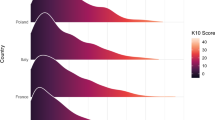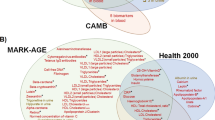Abstract
STEVENS's1 classification of types of scaling according to their group structure appears insufficient, since a higher ordered metric2,3 and an interval scaling both belong to the same group, namely, the linear group (an interval scaling according to Stevens and a higher ordered metric scaling because the only function ƒ(x) such that for all a, b, c, d, if ∣a−b∣ > ∣c−d∣ then ∣ƒ(a)−ƒ(b)∣ > ∣ƒ(c)−ƒ(d)∣ is a linear function), yet they contain different amounts of information.
This is a preview of subscription content, access via your institution
Access options
Subscribe to this journal
Receive 51 print issues and online access
$199.00 per year
only $3.90 per issue
Buy this article
- Purchase on Springer Link
- Instant access to full article PDF
Prices may be subject to local taxes which are calculated during checkout
Similar content being viewed by others
References
Stevens, S. S., Science, 103, 677 (1946).
Coombs, C. H., Psychol. Rev., 57, 145 (1950).
Siegel, S., in Psychological Scaling: Theory and Applications (J. Wiley and Sons, Inc., New York, 1960).
Stevens, S. S., Psychol. Bull., 55, 177 (1958).
Kendall, M. G., and Babington Smith, B., Biometrika, 31, 324 (1939).
Torgerson, W. S., Theory and Methods of Scaling (John Wiley and Sons, Inc., New York, 1958).
Shapiro, M. B., Brit. J. Med. Psychol., 34, 151 (1961).
Author information
Authors and Affiliations
Rights and permissions
About this article
Cite this article
PHILLIPS, J. Scaling and Personal Questionnaires. Nature 200, 1347–1348 (1963). https://doi.org/10.1038/2001347b0
Issue Date:
DOI: https://doi.org/10.1038/2001347b0
Comments
By submitting a comment you agree to abide by our Terms and Community Guidelines. If you find something abusive or that does not comply with our terms or guidelines please flag it as inappropriate.



